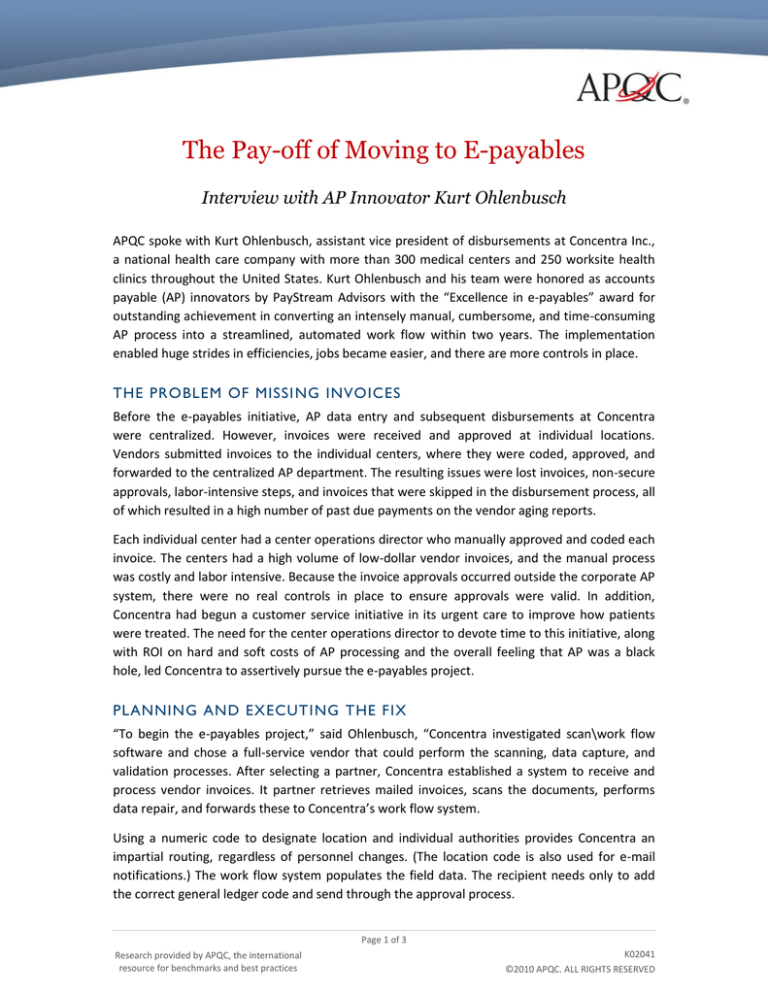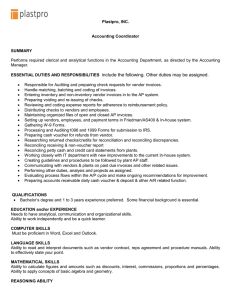
The Pay-off of Moving to E-payables
Interview with AP Innovator Kurt Ohlenbusch
APQC spoke with Kurt Ohlenbusch, assistant vice president of disbursements at Concentra Inc.,
a national health care company with more than 300 medical centers and 250 worksite health
clinics throughout the United States. Kurt Ohlenbusch and his team were honored as accounts
payable (AP) innovators by PayStream Advisors with the “Excellence in e-payables” award for
outstanding achievement in converting an intensely manual, cumbersome, and time-consuming
AP process into a streamlined, automated work flow within two years. The implementation
enabled huge strides in efficiencies, jobs became easier, and there are more controls in place.
THE PROBLEM OF MISSI NG INVOICES
Before the e-payables initiative, AP data entry and subsequent disbursements at Concentra
were centralized. However, invoices were received and approved at individual locations.
Vendors submitted invoices to the individual centers, where they were coded, approved, and
forwarded to the centralized AP department. The resulting issues were lost invoices, non-secure
approvals, labor-intensive steps, and invoices that were skipped in the disbursement process, all
of which resulted in a high number of past due payments on the vendor aging reports.
Each individual center had a center operations director who manually approved and coded each
invoice. The centers had a high volume of low-dollar vendor invoices, and the manual process
was costly and labor intensive. Because the invoice approvals occurred outside the corporate AP
system, there were no real controls in place to ensure approvals were valid. In addition,
Concentra had begun a customer service initiative in its urgent care to improve how patients
were treated. The need for the center operations director to devote time to this initiative, along
with ROI on hard and soft costs of AP processing and the overall feeling that AP was a black
hole, led Concentra to assertively pursue the e-payables project.
PLANNING AND EXECUTI NG THE FIX
“To begin the e-payables project,” said Ohlenbusch, “Concentra investigated scan\work flow
software and chose a full-service vendor that could perform the scanning, data capture, and
validation processes. After selecting a partner, Concentra established a system to receive and
process vendor invoices. It partner retrieves mailed invoices, scans the documents, performs
data repair, and forwards these to Concentra’s work flow system.
Using a numeric code to designate location and individual authorities provides Concentra an
impartial routing, regardless of personnel changes. (The location code is also used for e-mail
notifications.) The work flow system populates the field data. The recipient needs only to add
the correct general ledger code and send through the approval process.
Page 1 of 3
Research provided by APQC, the international
resource for benchmarks and best practices
K02041
©2010 APQC. ALL RIGHTS RESERVED
Concentra has also streamlined the approval process. The hierarchy is outlined in the system,
and approvals are attached as the invoices pass through the system. “There are three levels of
approvals that each vendor invoice passes through,” Ohlenbusch explained, “the assistant
center operations director, who codes, reviews, and approves the invoice; the center operations
director, who reviews and gives final approval for invoices under $1,000; and the area
operations director, who reviews and approves all invoices more than $1,000.”
After the documents are processed, there is a final review before the information is uploaded to
the ERP system. This review monitors the general ledger codes, makes any corrections (e.g., a
general ledger code is used incorrectly), and communicates any coding changes made.
In summary, the invoices move electronically through the system. After being scanned, the
invoices are routed using an assigned location number and all fields are populated, with the
exception of the general ledger code. Using this process, coding and approvals are streamlined,
and outstanding vendor invoices are paid more smoothly.
Ohlenbusch said that a new procedure was developed for bringing a new vendor properly into
the system. Authorizing a new vendor requires signed approval, after which a template is
created for that vendor. The new system captures the template and uses this for all this
vendor’s transactions going forward.
THE BENEFITS OF CHAN GE
In the past, Concentra had five employees devoted to researching the month-end vendor
statements and tracking down skipped invoices on the monthly aging. Now vendor aging has
improved because invoices are not lost or skipped. Concentra has found that the days of sales
outstanding for their suppliers has greatly improved, now that payments are in line with
Concentra’s target for days payable outstanding. The process has resulted in the ability to do
more with fewer staff.
The e-payables process has also increased the ability of Concentra to take advantage of vendor
discounts. And because of the process improvement, Concentra is more confident and is
approaching suppliers to negotiate discounts and payment terms. In the future, Concentra will
move to expand the e-payables process to e-payments. Currently, the organization uses paper
checks for disbursements.
Implementing the move to electronic processing of payables now allows more time for spend
analysis. It has greatly reduced the burden of accruing month-end outstanding AP. Under the
previous system, because invoices were slow to move through the system and sometimes lost,
the accrual at month end was a best estimate. Now, every invoice is accounted for, and accruals
are always accurate. The e-payables system assists to eliminate duplicate vendor payments,
with flags for potential duplicates built into the scanning systems and the ERP system.
Page 2 of 3
Research provided by APQC, the international
resource for benchmarks and best practices
K02041
©2010 APQC. ALL RIGHTS RESERVED
LOOKING AHEAD
Concentra’s focus now is on the refund management processes for accounts receivable.
Meanwhile, the organization is continuing to change the primary role of the AP staff from
chasing and processing paperwork to reviewing and solving problems by providing training and
development. The push is to increase efficiencies and enhance the processes.
“This is a long process with much work and change,” advised Ohlenbusch. “Do not try to
measure or look back short term, three to six months. Moreover, choose a partner with a strong
project manager who can offer input, guidance, and direction. Although the process is painful,
the efficiencies and cost savings are outstanding.”
ABOUT APQC
APQC is the leading resource for performance analytics, best practices, process improvement,
and knowledge management. The organization’s research studies, benchmarking databases, and
renowned Knowledge Base provide managers with intelligence to transform their organizations.
A member-based nonprofit founded in 1977, APQC serves Global 1000, government, and
nonprofit organizations. For information, visit www.apqc.org or call +1-713-681-4020.
Page 3 of 3
Research provided by APQC, the international
resource for benchmarks and best practices
K02041
©2010 APQC. ALL RIGHTS RESERVED


